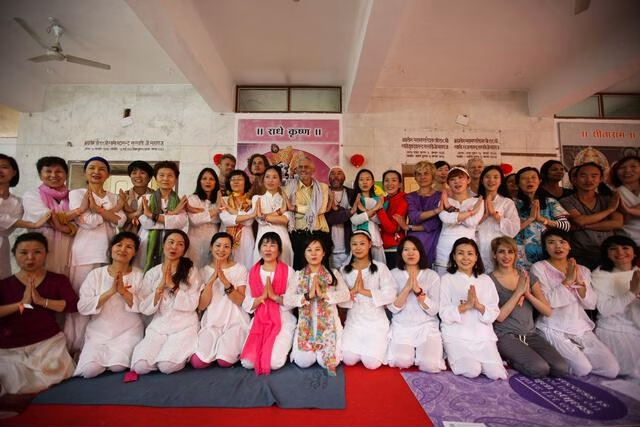Introduction – The Yoga Capital of the World
In the hills of Uttarakhand, at the base of the Himalayas, lies Rishikesh a quiet town that has become famous as The Yoga Capital of the World.
It is not just a travel destination. It is a place where people come to slow down, find peace, and reconnect with themselves.
Every year, thousands of visitors from across the globe come to Rishikesh to learn yoga, meditate, and experience India’s spiritual heritage. But what makes this city so special?
Let’s explore why Rishikesh is known worldwide as the heart of yoga and spirituality.
The Roots of Yoga in India
Yoga began in India more than 5,000 years ago. It is much more than stretching or exercise, it is a complete way to balance the mind, body, and soul.
Ancient Indian texts like the Vedas and Patanjali’s Yoga Sutras describe yoga as a path to self-realization and inner peace.
For centuries, sages and monks practiced yoga and meditation in the mountains and forests. The Himalayas were seen as a sacred land calm, powerful, and close to the divine.
Rishikesh, on the banks of the holy Ganga River, became one of the most important centers for this ancient practice.
Why Rishikesh?
Rishikesh sits where the Chandrabhaga and Ganga rivers meet. The city is surrounded by green hills and filled with the sound of flowing water and temple bells.
According to legend, a sage named Rishi Raibhya performed deep meditation here. Pleased with his devotion, Lord Vishnu appeared before him as Hrishikesha. That’s how the city got its name.
Because of its peaceful energy, saints and spiritual teachers began to live and teach here. Over time, Rishikesh became known as a place for self-discovery and spiritual learning.
The Beatles’ Visit – The Moment Rishikesh Went Global
For many years, Rishikesh was known mostly among Indian pilgrims. That changed in 1968, when The Beatles came to stay at the Maharishi Mahesh Yogi Ashram.
They came to learn Transcendental Meditation and ended up writing many songs during their stay. Photos of them meditating by the Ganga made Rishikesh world-famous overnight.
After that, people from all over the world started visiting to learn yoga and meditation. The once-quiet town became a global symbol of peace and mindfulness.

Rishikesh Today – Tradition and Modern Life Together
Modern Rishikesh beautifully blends ancient wisdom with today’s wellness culture.
On one side of the city, you’ll find temples, ashrams, and sadhus (holy men) chanting prayers. On the other, you’ll find yoga studios, cafes, and training centers filled with students from different countries.
The city has hundreds of yoga schools, many of them certified by Yoga Alliance. People come here to complete 200-hour or 500-hour teacher training courses and become certified yoga instructors.
Despite its growth, Rishikesh remains a holy city. Alcohol and meat are banned, keeping the environment calm and pure. The sound of bhajans (devotional songs) and the smell of incense fill the air, reminding everyone of the town’s spiritual roots.
Also read, How Taking the Wrong Vitamin D Supplement Can Harm Your Immune System
The International Yoga Festival
Every March, Rishikesh hosts the International Yoga Festival at Parmarth Niketan Ashram.
This week-long event brings together thousands of yoga lovers, teachers, and students from more than 100 countries.
The festival includes classes in different yoga styles Hatha, Kundalini, Iyengar, Ashtanga and more. There are also talks on Ayurveda, meditation, and Indian philosophy.
It’s not just about fitness or flexibility. The goal is to help people live a balanced and peaceful life, the real purpose of yoga.

Yoga as a Way of Life
In Rishikesh, yoga is not just about poses or physical health. It’s about living with awareness, kindness, and discipline.
The city teaches the eight steps of yoga given by Patanjali ethics, discipline, posture, breath control, focus, meditation, and finally, peace of mind.
Many seekers spend months or even years here. Some study in ashrams like Sivananda Ashram or Swami Rama Sadhaka Grama, while others take part in community service and spiritual gatherings.
Here, yoga becomes a lifestyle a way to live simply and mindfully every day.
How Yoga Changed the City’s Economy
Yoga has also transformed Rishikesh’s economy. The town attracts millions of tourists each year, supporting hotels, local shops, teachers, and small businesses.
The government promotes eco-tourism and spiritual tourism, encouraging visitors to respect nature and local culture.
Many ashrams now run zero-waste programs and eco-yoga retreats to protect the environment. This balance between growth and spirituality is what makes Rishikesh stand out from other tourist spots.
Also read, Zoho: The Indian Tech Giant Redefining Global SaaS, and the Vision of Founder Sridhar Vembu
Famous Ashrams and Spiritual Centers
Rishikesh is home to several famous ashrams, each offering something unique:
- Parmarth Niketan: Known for its peaceful atmosphere and daily Ganga Aarti.
- Sivananda Ashram: Founded by Swami Sivananda, offers yoga and spiritual study.
- Beatles Ashram (Chaurasi Kutia): The historic place where The Beatles stayed.
- Anand Prakash Yoga Ashram: Focuses on traditional Hatha Yoga and philosophy.
These places are not just yoga schools; they are centers of healing, learning, and peace.
The Evening Ganga Aarti – A Divine Experience
Every evening, people gather at Parmarth Niketan or Triveni Ghat to witness the Ganga Aarti.
As lamps float on the river and priests chant mantras, the sky fills with light and devotion. The moment feels timeless a reminder that yoga and spirituality here are not performances, but a living tradition.

Global Influence of Rishikesh
Yoga schools inspired by Rishikesh have now spread all over the world. From New York to Tokyo, many yoga teachers trace their roots back to this small Indian town.
Hospitals, schools, and even companies now include yoga and meditation in their daily routines techniques that began in places like Rishikesh.
The recognition of June 21 as International Yoga Day by the United Nations in 2014 further strengthened Rishikesh’s global importance as the birthplace of modern yoga culture.
Challenges – Keeping Yoga Real
With fame has come a challenge commercialization.
Some places now market yoga as a luxury experience, forgetting its true meaning. Expensive retreats and social media trends sometimes overshadow the simple, spiritual side of yoga.
True teachers in Rishikesh remind everyone that yoga is not about showing off. It’s about understanding yourself and finding peace within.
To maintain quality, the Indian Ministry of AYUSH and Uttarakhand Tourism are now certifying genuine yoga centers and promoting authentic practices.
Why Rishikesh Still Matters
In today’s fast-paced world, Rishikesh remains a place to slow down. The sound of flowing water, the chanting of prayers, and the calm mountain air create a perfect setting for reflection.
Rishikesh shows the world India’s soft power the ability to inspire through wisdom, peace, and tradition.
Visitors come here searching for yoga, but most leave with something deeper a sense of balance and self-awareness.
Planning a Trip to Rishikesh
Best time to visit: February to April, or September to November.
Nearest airport: Jolly Grant Airport, Dehradun (21 km away).
Distance from Delhi: Around 240 km by road.
Popular places to see:
- Parmarth Niketan Ashram
- Lakshman Jhula and Ram Jhula
- Beatles Ashram
- Triveni Ghat
- Neer Garh Waterfall
Activities to try:
Yoga retreats, Ganga Aarti, meditation, Ayurvedic therapies, and river rafting.

Conclusion – Where the Ganga Teaches Silence
Rishikesh is more than just a city. It is a place that teaches you to live simply and think deeply.
Here, the Ganga flows endlessly, carrying with it centuries of wisdom and devotion. The calm energy of this land reminds us that yoga begins when you start living with awareness and kindness.
In Rishikesh, peace isn’t something you look for it’s something you feel.



